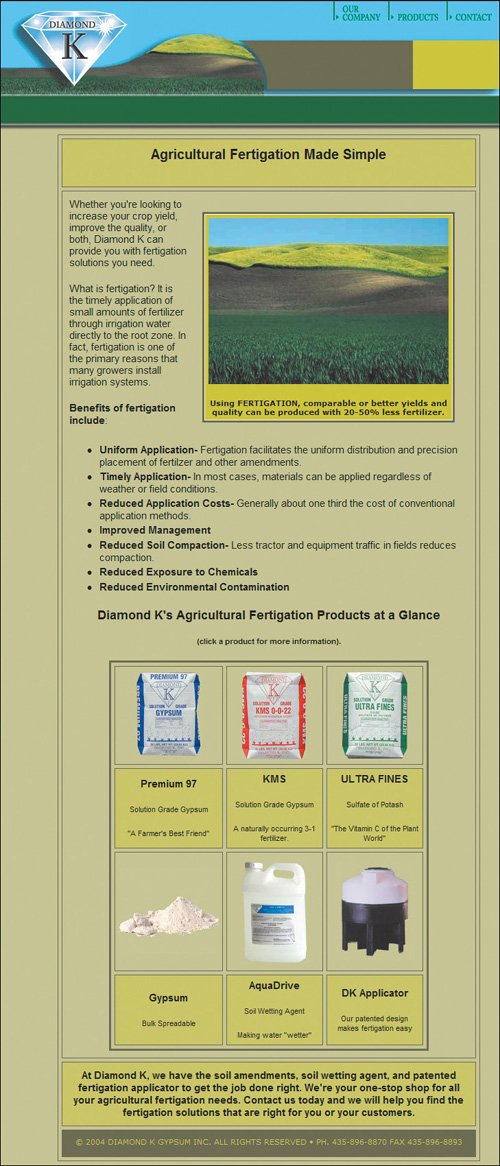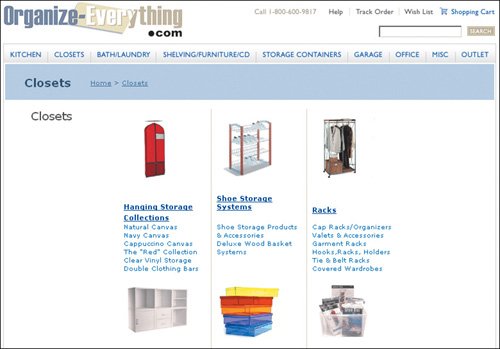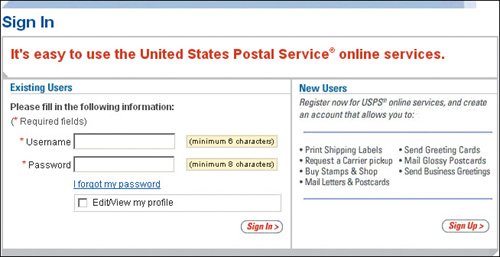Adaptation: How Users Have Influenced Usability
| Even though we have many of the same users today as we did ten years ago, they have adapted over time to the online environment and learned more about how to use Web sites. As a result, six usability issues have become less of a problem and have lost skulls in our rating.
As users have adapted to the online environment and learned more about how to use Web sites, six usability issues have become less of a problem. Over years of Web exposure, audiences are slowing adapting to these problems:
Uncertain ClickabilityIn early studies, we often found that users didn't know where to click on screens. Early Web pages were often highly graphical, and links were hidden in pictures that gave no suggestion of clickability. Of course, if users overlook a link, they will never find whatever information is lurking at the other end of it, so this is a very serious usability problem. Whenever you find yourself having to give instructions for where users can click, you know you have a usability problem. The Diamond K site needs to say, "click a product for more information" because the product photos don't look clickable. Making the product names into hypertext links would have solved the problem and eliminated superfluous instructions. (It would have been fine to retain the product photos as supplementary links, but it's better not to rely on users clicking things that don't look like links or buttons.)  www.diamondkgypsum.com Today users are very accustomed to the conventions for clickability on the Web. They know that text can be clicked if it's colored and underlined. And they know that graphics can be clicked if they have a raised, 3D appearance that makes them look somewhat like buttons. As long as you stick to these two design conventions, your users should have no problem knowing where they can click. (Knowing why they should click on a link is another matter, of course.) What would you select to bypass the intro page? How about "skip intro"? On this page, "skip intro" does nothing. Contrary to user expectations, the way to bypass the intro page is to select the British or American flag. One might argue that this saves people time by combining two steps into oneselecting a country and skipping the intro. However, contradicting users' interaction models causes more harm than good. Any timesaving is overshadowed by the potential for errors and frustration. Besides, intro pages are a waste of time.  www.bicsportsurfboards.com Links no longer have to be blue. Here it's obvious that Bulletin and "Cooperative Bachelors Degrees" are the links in the body text because they are colored and underlined. It's also reasonably obvious that the user has already visited Bulletin because this link is a less-luminous version of the primary link color.  www.p-i-m-s.com (Facing page, bottom) The bold blue underlined headings on this page indicate clickability when in fact they're not clickable. Blue text provides strong cues of clickability, especially when underlined or used for menu items. The misuse of visual cues causes confusion because the interface doesn't respond according to people's expectations. Violating Web conventions reduces user confidence and discourages people from using a site.  www.organize-everything.com This problem now merits only one skull because it's so relatively rare. Yet sometimes we come across Web sites with headlines that are clickable even if they don't look it, and we have found a good deal of clickability problems with young children. So this issue is not down to zero skulls yet. Links That Aren't BlueIn earlier years, we recommended that links be blue because that was the color people associated with clickability. But today's users have seen links in many other colors. Other colors work just as well as long as they stand out clearly from the body text and change to a different color after the page they link to is visited. If you don't have a particular reason to prefer another color, we still recommend blue as the safest choice. But going with another color has such tiny potential for causing trouble these days that it is no longer worth even one skull.
Reluctance to scroll persists. It's still fairly common to see users give up on a page too quickly because it doesn't seem relevant to them. ScrollingAs discussed in Chapter 2, some users still don't scroll Web pages when they navigate a site to determine where to go (or whether to leave). This is not nearly as serious a problem as it was in the early days of the Web, when we saw many users rarely or never scroll. Now people have gotten used to long Web pages and have learned that they sometimes have to scroll. If users decide to dig into a page, they usually know how to scroll. Yet reluctance to scroll persists. This issue is not endemic to the Internet. Newspaper people put their top stories above the fold on the front page to make sure they're seen on newsstands and doorsteps even before readers unfold their papers to read them. On the Web, it's still fairly common to see users give up on a page too quickly because it doesn't seem relevant to them when in reality the information they needed was "below the fold" and just not visible during first scan. (Facing page, top) The graphical design and layout of the Atlantis homepage provides inadequate cues to let people know that there's more information below the viewable browser window. The image of the resort fits perfectly within the window and the "Begin Your Adventure" heading at the bottom looks like it marks the end of the page. Make sure that design elements don't look like end-page markers. Even experienced Web users need cues to indicate that there is relevant information below the viewable area. Unfortunately, on this site there are many more interesting areas at the bottom of this page that people won't know about.  www.atlantis.com The Atlantis homepage, scrolled down: Look at all the interesting information people can miss. All key information should be visible on the initial screen. Customers often decide whether to do business based on what they see without scrolling. Remember to check your pages on different screen resolutions to make sure that there are sufficient visual cues in the viewable area to pique people's interest and let them know there's more below.  www.atlantis.com We still give scrolling two skulls as a usability issue because it continues to hurt sites more than it should. This is probably because of differences in how designers and users judge relevancy. People who work on Web sites know when a given page is the solution to a given problem, and they may assume that users will scroll down to look for the link to that solution. And readers would if they knew that it was waiting for them. But of course, users don't know any such thing. During the initial few seconds when they judge a page, they may make their decision based on what's visible. If this doesn't seem promising enough, some will leave without investing the extra time to scroll. RegistrationIn the early days of the Web, registration was a huge barrier, and people didn't know whether to trust sites with their personal information. Now people are more used to entering this information as long as they trust the site and want the service or products it offers. Today users know how to register on a site if they have decided to do business there. Also, many e-commerce sites have designed alternate checkout paths where users can complete their purchases without officially having to register. Of course, users must enter most of the same personal information, including their credit card numbers, but to many people that's less intrusive when it's part of a checkout process. The United States Postal Service requires customers to register before purchasing products from its site. Allowing people to buy without registering is a better approach for sales because there are fewer opportunities for drop off. For example, it's common for people try to register by creating a new user name and password in the wrong area, even if it's labeled "Existing Users." People are simply drawn to text boxes and immediately fill in information and then are confused when the system returns error messages. Making registration optional at the end of a purchase is less offensive to customers because it doesn't interrupt shopping and gives them a choice.  www.usps.com Still, users don't like to register on Web sites, and sites lose a lot of business if they force users to register prematurely or if they ask too many nosy, privacy-invading questions. All in all, registration is still a cause of lost business, but not nearly as much as it was in the past. One skull. Complex URLsURLs are as bad as ever, even though complex URLs hurt both usability and search engine optimization. There is no reason for URLs that are several hundred characters long, since that's more than necessary to provide a unique address for every atom in the known universe. Most Web sites have less than a million pages and should work fine with URLs of 20 to 50 characters.
There is no reason for URLs that are several hundred characters long, since that's more than necessary to provide a unique address for every atom in the known universe. We have downgraded complex URLs to a two-skull usability problem because users no longer rely on them very much when interpreting a Web page or navigating a site. Expert users will still "hack" a URL from time to time, but this is now relatively rare, so URLs that are difficult to manipulate are not as harmful as they used to be. There are also services like TinyURL to help expert users create a shorter URL if they want to email a reference to friends or colleagues. Pull-Down and Cascading MenusIn the past, any dynamic element on the Web commonly confused users, but now people are used to dynamic elements such as pull-down menus and even hierarchical menus that cascade a few levels. The more complex the menu, the more difficult it is to manipulate, so we still give one skull to cascading menus, which present usability problems when they are overly elaborate or long. Think twice any time you are tempted to use anything beyond a simple menu, but you can do it if it truly helps the site. Do watch out for accessibility problems, though, and remember that people with physical disabilities have more difficulty controlling the pointer. |
EAN: 2147483647
Pages: 107